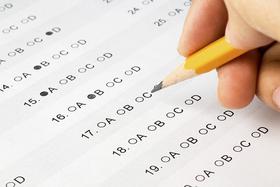How to Study for an Exam
Exams can be nerve-wracking at any age. So, show your child where exams fit in and, more importantly, how to prepare for them. From early grades, teachers evaluate your child's learning through different methods.
Canva generated this picture of a student studying for an exam.

The Purpose of Exams
Exams are a formal, structured method of assessment.
- Unfortunately, what makes exams stressful in high school, college, and in our professional lives is that so much is riding on them.
- For example, you must pass the LSAT to get into law school.
- Then, you must pass a state bar exam to practice law.
- The pressure to succeed is enormous.
That's why I recommend you tell your child how you handled preparing for and taking the exam. The more your child understands how exams work and how to handle them, the more successful she is likely to be.
Exams and tests are a great way to assess what the students have learned with regards to particular subjects. Exams will show what part of the lesson each student seems to have taken the most interest in and has remembered. Source: Edu-Quip
Understand Your Learning Style
As soon as you can, identify your child's learning style.
- Observe her preferences and tendencies in how she processes and retains information.
- Contrast that with how you learn and what has worked for you.
- Sharing how you learned will help her understand how she knows.
- Understanding how she learns will make her studying and exam preparation more efficient.
Identify a Place to Study
Create a quiet place for your child to work.
- Beginning in kindergarten, that quiet place can include a work surface where she can draw, play with busy boards, stack toys, and do all the other things a toddler enjoys exploring.
- As she ages, you can expand her study environment to include shelves and other storage for her books, art equipment, and science projects.
- When you give her a tablet and show her how to use it to explore subjects that appeal to her, it is a matter every parent needs to consider carefully.
- Teach her that technology is a tool to be used as needed.
- No matter the age, minimize distractions. She must learn to use all of her senses to absorb and retain information effectively.
This video offers suggestions for studying smarter.
Manage Your Study Time
Start her young!
- At an early age, set aside some time for her to draw, read, and play with her toys.
- That way, transitioning to actual study time as she grows older will be expected.
- Once she is in high school, share the tools you have found helpful in your life and work.
Use Active Learning Strategies
Your child began to learn actively. However, as she grows older, she should devise new ways and approaches to maintain active learning.
Active learning refers to a broad range of teaching strategies which engage students as active participants in their learning during class time with their instructor. Typically, these strategies involve some amount of students working together during class, but may also involve individual work and/or reflection. These teaching approaches range from short, simple activities like journal writing, problem solving and paired discussions, to longer, involved activities or pedagogical frameworks like case studies, role plays, and structured team-based learning. Source: Center for Educational Innovation at the University of Minnesota
Develop Effective Note-taking Skills
The first step in note-taking has to be keyboarding.
- I never learned how to type correctly, but I made sure that my children learned how to type.
- Watching their fingers fly over the keyboard at 90 words per minute made me realize how important that skill is for note-taking.
- The result is the same whether you write notes by hand or keyboard.
- The information you have written or typed somehow becomes a part of your memory bank. Once you have information committed to memory, you can recall it as needed. So, teach note-taking as soon as you can.
- Show her that she took notes to review them later.
- When you demonstrate how to review information you have saved, review and enhance her note-taking skills to be appropriate to her grade level.
This video offers a crash course in note-taking.
Utilize All Your Resources
Information, explanations, and help come in various forms.
- Let her know that she should seek help from teachers, tutors, or classmates when needed.
- Show her that she can find many resources online, such as study guides and practice exams.
Develop Healthy Study Habits
You know how important adequate sleep, nutrition, exercise, and stress management are to your overall health.
- Ensure that she understands the importance of her health.
- Private schools have always subscribed to the concept of a healthy mind in a healthy body.
The 2nd-century Roman poet Juvenal stated, "orandum est ut sit mens sana in corpore sano," which translates as: "You should pray for a healthy mind in a healthy body."
Learn How To Take a Test
Practice! Practice! Practice! That's the best advice you can offer your child.
- Understand the format of the test.
- That way, there will be few surprises on the test day.
- Show her that there are several formats for tests.
- Make sure she has plenty of practice.
- Finally, constant encouragement is the gold standard for teaching your child how to take tests successfully.
Conclusion
Successful exam preparation begins with establishing strong study habits early in your child's education. By understanding their learning style, creating an effective study environment, and developing consistent routines, students build confidence and competence in test-taking. Remember that your guidance and encouragement, combined with practical study strategies and healthy habits, create the foundation for academic success throughout their educational journey. Have a plan and work that plan. It will evolve, but the plan will be your guide for helping your child develop confidence in taking tests.
Questions? Contact us on Facebook, Instagram, and You Tube. @privateschoolreview
#StudyTips #ExamSuccess #HighSchoolLife #TestPrep #TimeManagement #ActiveLearning #StudyHabits #StudentLife #SuccessTips #Education














